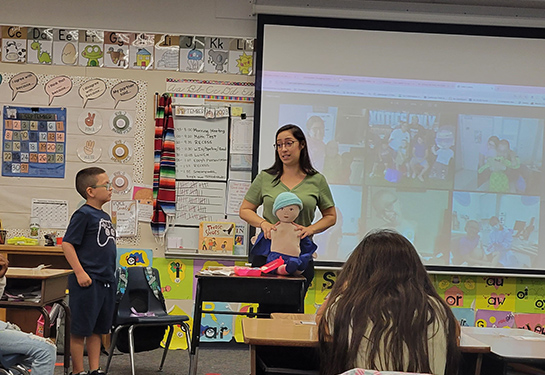New study finds combination of telemedicine, in-person visits best fit for asthma care
Can telemedicine improve asthma care for pediatric and young adult patients?
A new UC Davis Health study reviews telemedicine use among patients with asthma. The researchers identify best practices that can minimize health disparities, maximize patient experience and increase access. It is the first study to evaluate provider-to-patient telemedicine use for asthma care among children and young adults. The study was published this month in the Journal of Asthma.
Asthma is the most common health condition among young people in the United States, affecting about 8% of children and young adults. Previous studies have found that children with asthma experience more than double the number of missed school days than thosewithout asthma.
“Because asthma is one of the most common, chronic conditions of childhood, optimizing the delivery of care to families is of unique importance. We wanted to explore if telemedicine is a convenient solution for parents and patients with asthma care needs,” said Rory Kamerman-Kretzmer, UC Davis pediatric pulmonologist and one of the study authors.
The UC Davis Pediatric Telemedicine Program was one of the first programs of its kind in the nation to provide physicians and patients with real-time remote consultation and evaluation though interactive, high-definition video and audio communication.
A mixed method study using electronic health records, focus groups
Researchers analyzed the electronic health records of all patients, ages 2-24 who were seen at UC Davis Health for a primary diagnosis of asthma during California’s statewide shelter-in-place order (March 19, 2020 to Sept. 30, 2020). A total of 502 patients met the criteria. Of these patients, 207 had at least one telemedicine visit. Of the remaining patients, 265 had in-person visits only, and 27 had telephone visits. Three had a combination of in-person and telephone visits.
Most patients in the study were male (57.6%), lived in urban areas (85.5%), spoke English as a primary language (96%) and had private insurance (65.5%). Patients who spoke a primary language other than English were much less likely than English-speaking patients to adopt telemedicine for asthma care during the pandemic.
Since UC Davis Health serves a 33-county area, many patients travel great distances to get to the clinic in Sacramento. In this study, more than 10% of patients traveled more than 100 miles to get to UC Davis Health.
Video visits can save time but in-person visits preferred for patients with asthma
From the group of 502 patients, researchers randomly selected 12 parents of pediatric patients and five young adult patients to take part in a one-hour focus group session through videoconference. Three focus groups were held.
Focus group participants were asked to compare the way that providers engaged with patients through telemedicine and in person. Some of the common themes and findings were as follows:
- Both parents and patients expressed that it was difficult to establish trust and rapport with a new provider over telemedicine.
- Parents felt that a physician’s in-person presence was more effective for counseling pediatric patients about the importance of medication and teaching them about asthma.
- Parents felt that pediatric patients were more actively engaged when the visit was in-person.
- Telemedicine visits were more likely to involve one physician, rather than the entire care team. Parents preferred to speak only with one physician.
- Telemedicine allowed parents and patients to see their specialist without spending significant travel time. Parents also appreciated telemedicine visits as a way to protect their children during the pandemic.
- While some parents were willing to take pulmonary function measurements at home, many did not feel confident in their ability to use home monitoring equipment like peak flow meters and home spirometers.
- All participants who used telemedicine expressed that scheduling follow-up appointments was more difficult than in-person appointments.
- Nearly all focus group participants agreed that a combination of telemedicine and in-person visits would be preferred when asthma is well-controlled.
Improving access and ensuring equity
Families noted that while telemedicine improved their access to care, it did not completely replace in-person visits. Parents and patients still found value to in-person visits, particularly when meeting care providers for the first time or when receiving asthma education or medication management information. Parents also preferred that care providers take patient measurements during office visits, rather than train them on how to use equipment at home.
“The study shows that alternating telemedicine and in-person visits for routine asthma care is the preferred mode of care for many parents, said Sarah Haynes, lead author of the study and assistant professor of pediatrics at UC Davis Health. “This option balances the increased convenience of telemedicine visits, while still ensuring that kids get the physical exams and measurements they need.”
The study also highlights an important opportunity to improve health equity by increasing access to telemedicine for families dealing with asthma who speak a primary language other than English.
The study was funded by a Children’s Miracle Network at UC Davis grant.
The coauthors of the study were Shahabal Khan, Stephanie Crossen, Monica Lieng, James Marcin, Nicholas Kenyon and Christopher Kim, of UC Davis Health. The study was a multidisciplinary collaboration between the UC Davis Center for Health and Technology, epidemiology, pediatric pulmonology and general pediatrics at UC Davis Health.




